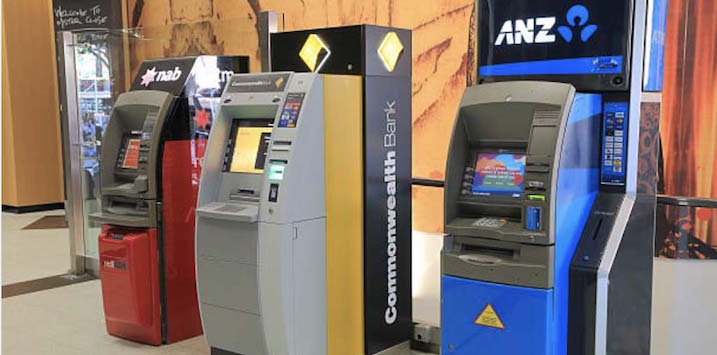
Major banks put an end to the great ATM rip-off
The major banks recently announced they will no longer charge fees to customers using their ATMs, even if they are accessing an account with another bank. This is a pretty big change in policy, and carries some downside risks. So, why did they do it, and what does it mean for investors?
Commonwealth Bank was the first to announce the removal of fees, and it was quickly followed by Westpac, ANZ and NAB.
The decision to remove ATM fees is an attempt to the improve public perception of the major banks, but it raises a few concerns in terms of financial impacts.
The obvious primary impact is on fee revenue. Fee revenue is a very high Return on Equity (ROE) source of income for the banks, which have been under pressure for a number of years due to class actions against penalty fees and regulatory caps being placed on interbank charges on credit cards. This will add to the downward pressure on fee revenue. While the banks have not provided ATM fee revenue figures to the market, it is likely the lost revenue will impact major bank earnings by less than 0.5 per cent.
The other impact is more interesting. The competitive position of the major banks will be eroded slightly by the change. Transaction banking is at the heart of the competitive advantage of the major banks. One of the things that supports this position is the scale of their respective ATM networks. The need to provide customers with ready and convenient access to their cash adds a cost to smaller banks or their customers through the need to access the ATM networks of the majors. With the major banks removing these fees, they lose one of their scale advantages in transaction accounts. Therefore, ATM accessibility will no longer be a reason for a customer to choose a major bank. As such, this is a positive for the smaller regional banks.
It could also see existing major bank customers downgrade their accounts to lower fee accounts that previously charged for ATM access above a certain level. However, this is likely to be a very minor or negligible issue in terms of financial impact.
From a competitive perspective, this would have been unthinkable even 5 years ago. However, ATM usage has been in decline over the last few years as a result of tap-and-go and digital transfer products. As a result, the ATM network of the banks was a declining source of competitive advantage anyway. Therefore, it is possible that the positive public relations from scrapping the fees could outweigh the risk in accelerating rate of decline in the barriers to entry into the transaction banking market.
As an aside, the profitability of private companies that provide ATMs is likely to be devastated by this announcement. A large proportion of the fees paid on ATM transactions relate to privately owned ATMs. With the major banks removing their fees, it will be difficult for these privately owned ATMs to draw customers other than on ATMs that have no alternative in the area. Most of the privately owned ATM owners are likely to see their investments materially devalued by this change.
This post was contributed by a representative of Montgomery Investment Management Pty Limited (AFSL No. 354564). The principal purpose of this post is to provide factual information and not provide financial product advice. Additionally, the information provided is not intended to provide any recommendation or opinion about any financial product. Any commentary and statements of opinion however may contain general advice only that is prepared without taking into account your personal objectives, financial circumstances or needs. Because of this, before acting on any of the information provided, you should always consider its appropriateness in light of your personal objectives, financial circumstances and needs and should consider seeking independent advice from a financial advisor if necessary before making any decisions. This post specifically excludes personal advice.
INVEST WITH MONTGOMERY
The CBA hasn’t charged me any ATM fees in years, even though I do use them.
They waive ATM fees to many of their customers.
Hi Carlos, the change is that as a CBA customer, you now won’t be charged for using Westpac, NAB or ANZ either.
For people like me this is a non-event. I have not used an ATM for the last 5 years, when I need cash I take a cashout when I shop at either Coles, Woolworth or Aldi.
So no fees and more secure than an ATM.
Hi Stuart,
Regarding This
“Therefore, ATM accessibility will no longer be a reason for a customer to choose a major bank.”
I believe banks will charge each other for accepting each other’s cards. So there is some incentives to install more ATMs.
Hi Jack, I would expect the banks to apply some charge to other banks for the use of their ATMs by the other bank’s customers. However, because it is not the customer paying the fee, the charges are a zero sum game for the banks. But my point in the quote above is that from a customer’s perspective, the decision on whether to bank with a major or a regional/non-bank for transaction purposes has potentially changed. Some customers might have chosen to bank with CBA because it has the biggest network of ATMs providing the customer with more convenience in accessing their cash. This has been a limiting factor for the smaller players as they don’t have meaningful ATM networks. So either they had to pay for the customer’s access to ATM of other banks, which or negatively impacts margins, or the customer had to pay the A$2 fee to withdraw money, negatively impacting the value of the product to the customer. With the majors removing ATM fees, this disadvantage is removed as I can now have my transaction account with Bendigo Bank and access all of ATMs owned by the majors for free.